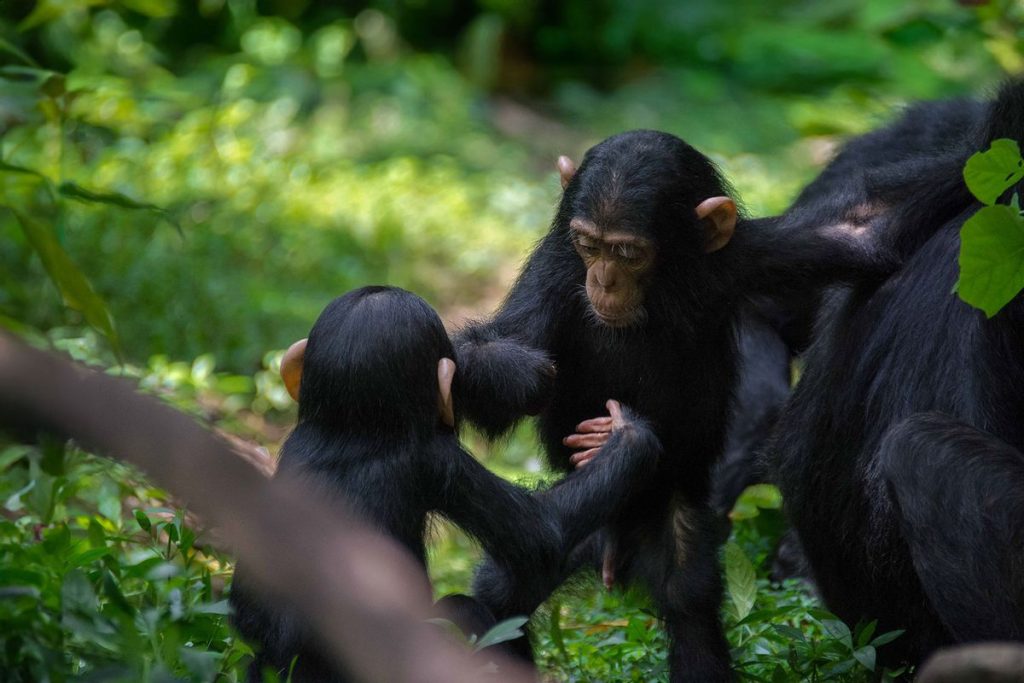When people talk to each other, the conversation usually contains many dramatic turns. Humans don’t speak naturally in Shakespearean monologues, but rather interrupt periodically and gesticulate wildly. It’s commonly believed that our conversations have a major turn roughly every 200 milliseconds. New Research Chimpanzees do the same thing, according to a study published in the journal Current Biology.
“They go on for a long time saying ‘groom me’, ‘no you groom me’, ‘no me’, until one of them gives in and makes the first move.”
“Chimpanzees also engage in rapid alternations from signal to signal during face-to-face gestural exchanges,” the authors write, to a degree similar to that of humans. “This agreement in face-to-face communication between humans and chimpanzees indicates common ground rules for communication.” The authors speculate that this could be because chimpanzees and humans share the same ancestors, or that by chance, both groups have developed similar strategies to coordinate their communicative interactions and manage competition.
The scientists learned this by collecting data on chimpanzee “conversations” in five wild communities in East Africa. In the end, they collected more than 8,500 gestures from 252 individuals. The scientists focused specifically on the chimpanzees’ turn-taking and conversation patterns. They ultimately found that 14% of communication exchanges included multiple exchanges of gestures and interruptions between between two and seven individuals.
Study co-author Dr Katherine Hovaiter, from the School of Psychology and Neuroscience at the University of St Andrews, observed this first-hand during her research.
“I remember seeing two big males engaged in a grooming contest. They both ended up grooming each other, but it wasn’t their goal to groom first, because that would mean they would lose a bit of social prestige.” Hobaiter said:They went back and forth for a long time: ‘Groom me,’ ‘No, you groom me,’ ‘No me,’ until finally one of them gave in and took the first step.’ Chimpanzees behave similarly when courting: ‘It can sometimes take sustained effort for a male to convince a female that he’s worthy of her time.’
A group of chimpanzees, including mothers, young children, juveniles and infants, groom and play together at Budongo Conservation Field Station in Uganda. (Photo by Catherine Hovaiter)
Scientists who study chimpanzee communication have suspected that these types of interactions occur frequently, but reliable data to back it up has been hard to get. Like humans, chimpanzees spend most of their time in groups, so they don’t need much interaction to communicate. As a result, chimpanzees say things like, “I’m“It’s taken us decades to get a data set large enough to really start to explore this aspect of their communication,” Hovalter said.
In contrast, primatologists have had a wealth of information about the physical manifestations of chimpanzee intelligence: For decades, they have recorded chimpanzees using tools and playing with toys, and it’s easier to observe these signs of intelligence than more subtle ones, like nuances of communication.
“Our research on chimpanzee culture has often focused on tool use, but human culture includes much more: social behavior, language, song, dance, fashion and more. There is growing evidence that other ape species may share the capacity for personal and cultural expression in communication,” Hobeiter said.
Want more health and science news delivered to your inbox? Subscribe to Salon’s weekly newsletter Lab Notes.
“There is growing evidence that other great ape species may share this capacity for personal and cultural expression.”
But for scientists to interpret and understand these chimpanzee cultures, they first need to understand how they communicate with each other. Fortunately, just as humans follow certain consistent rules when talking to each other, chimpanzees who talk to each other also follow the same basic behaviors.
“We knew that chimpanzees gesture, and we knew that in humans, speech across different languages shares tight timing of 200 milliseconds, with small but consistent cultural differences,” Hobeiter said. “Japanese speakers speak quickly, whereas Danish speakers speak slowly.”
But until this recent study, scientists weren’t sure whether chimpanzees share these timing structures in their conversations. Chimpanzees do just that, even displaying subtle cultural changes that add spice and richness to human culture.
“We never expected to see such small but consistent differences between groups,” says Hobeiter, “and in our case, the chimpanzees from Sonso in northwestern Uganda are the ones that are slow to take turns.”
This research not only helps humans learn more about chimpanzees, but it may also help us learn more about ourselves.
“This is a great example of another similarity between humans and other great apes, and a good reminder that we need to look beyond superficially similar behaviors to identify shared characteristics,” Hobeiter said. “For example, we often compare spoken language with the vocalizations of other species, but we can express language in many different ways, and there is no reason to assume that other species’ communication is vocally biased. In the case of chimpanzees, the fast-paced turn-taking that is characteristic of language can be seen in their gestures.”
She speculated that other animals might be missing similar nuances of communication: “Maybe we’re seeing alternating colour signals in octopuses!”


